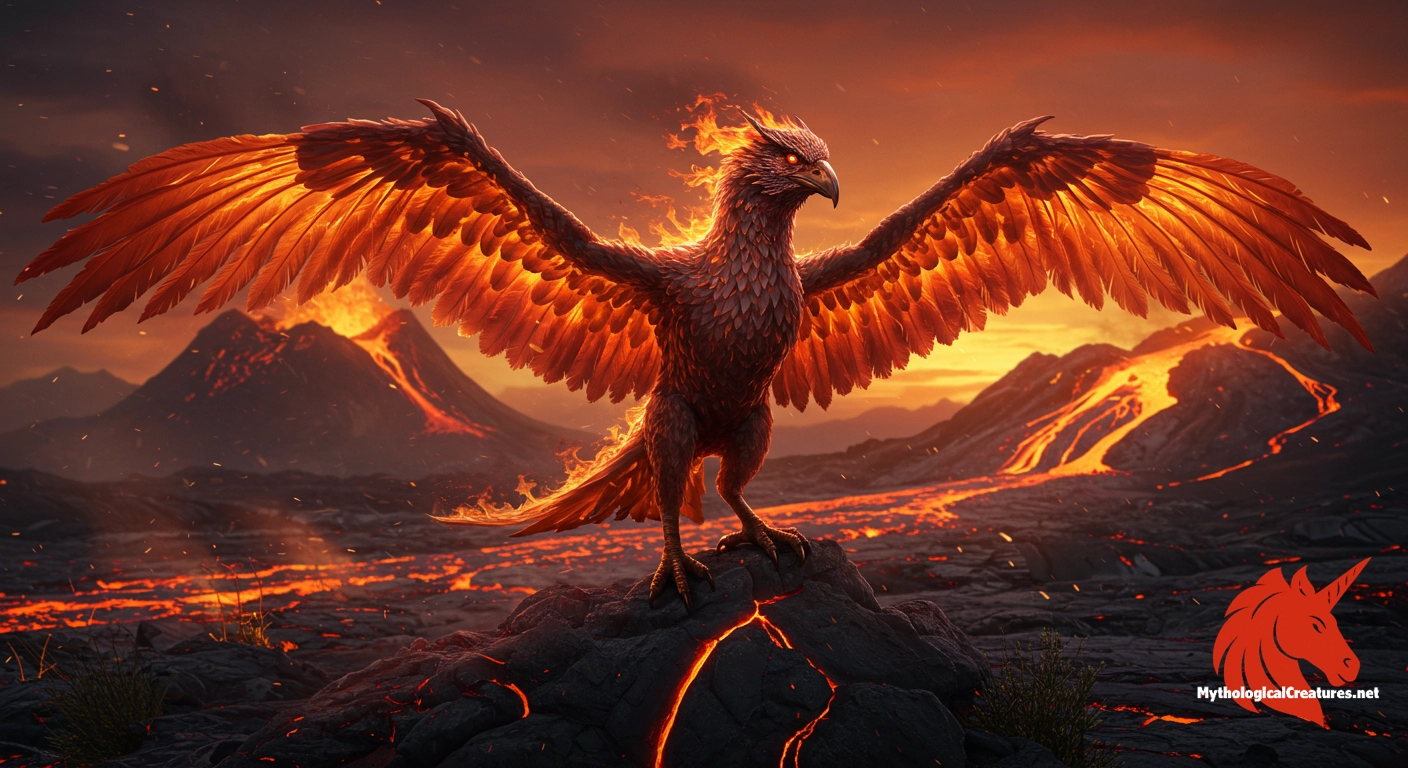Raróg: Raróg is a legendary Slavic fire demon traditionally depicted as a fiery falcon that can also appear as a dragon or a tiny bird, depending on the regional folklore.

Raróg
Raróg - Embodies the unpredictable and dualistic nature of fire in Slavic mythology, symbolizing both destruction and fortune
Origins & First Encounters
The Raróg stands as a striking figure in the tapestry of Slavic mythology, intricately woven into the legends of Czech, Slovak, Russian, Belarusian, and Ukrainian cultures. Its origins trace back to ancient oral traditions that celebrate the transformative and at times unpredictable nature of fire. The creature is often depicted as a fiery entity, at once embodying both the brilliance of a majestic falcon and the ferocity of a fearsome dragon. This dual representation captures a deep symbolic connection with the cycle of destruction and renewal that fire inspires in human imagination. Tales recount that the Raróg hatches from an egg incubated by the sustained heat of a stove for nine days and nights, lending the myth an almost ritualistic quality. Its presence in myth emphasises fire’s role as both a creative and destructive force, mirroring the ebb and flow of life itself. The creature has long been seen as an omen, evoking both caution and wonder among those who encounter its legend. Over the centuries, storytellers have preserved its image as a potent emblem of change and renewal. Even in modern times, the Raróg continues to enchant audiences, linking past and present with the timeless allure of myth.
Source Texts & Tale Variants
The earliest accounts of the Raróg emerge from a rich tradition of oral storytelling that spans multiple Slavic regions. Narratives have been recorded in folklore anthologies and local tale compilations, capturing its enigmatic presence over the ages. In Czech folklore, for example, there is a detailed account of the creature hatching from an egg warmed on a stove for nine successive days and nights. Distinct versions of the myth also appear in Slovak and Ukrainian traditions, each emphasising unique aspects of its fiery nature. Russian and Belarusian sources similarly weave the Raróg into stories that balance awe with a hint of foreboding power. Polish traditions contribute another variant, portraying the creature as a diminutive pocket-sized bird that brings happiness to its owner. These varying stories reflect the creative ways different cultures interpret and adapt the myth. Early folklorists and local chroniclers made efforts to document these legends, ensuring that the creature’s story would be passed down through generations. As diverse as the regions are, the layered narrative of the Raróg continues to captivate modern audiences while retaining its ancient mystique. The multiple sources and story variants collectively provide a fascinating glimpse into the multifaceted nature of this legendary fire spirit.
Form & Powers
The physical manifestation of the Raróg is as volatile as it is visually striking, with a body that appears to be forged in flames. Many accounts describe it as assuming the sleek form of a falcon with feathers that glisten like the embers of a burning fire. Its eyes are frequently depicted as luminous orbs, glowing with an intensity that mirrors the fierce heat of a blazing hearth. In some renditions, the creature displays draconic attributes, with sinuous, scaled features reminiscent of hardened lava. The contours of its form are often outlined by a radiant aura, making it seem as though it is perpetually surrounded by a halo of molten light. Some tales introduce a contrasting image by describing a smaller, almost diminutive version of the Raróg that captivates with its unexpected charm. There are also depictions where elongated wings leave trails of sparkling sparks, evoking the visual drama of a volcanic eruption. Artists have captured the interplay between shadow and flame on its form, enhancing an impression of ceaseless motion even in moments of stillness. The detailed imagery reflects the merging of natural fire elements with the mythmaker’s creative prowess. This vivid physical portrayal stands as a testament to the enduring power of Slavic myth to transform the elements into living symbols of wonder.
Regional Faces
Across the sprawling tapestry of Slavic lands, the Raróg has assumed remarkable local identities that reflect regional customs and environmental influences. In Czech and Slovak traditions, it is often conceptualised as a grand symbol of elemental fire, with a formidable presence that commands respect. Eastern Slavic narratives, shaped by the vast landscapes and unpredictable climates, sometimes infuse the legend with traits akin to draconic omens and natural forces. In contrast, Polish folklore offers a gentler variant where the creature appears as a diminutive bird that can be kept in one’s pocket, symbolising compact but potent good fortune. Such regional adaptations reveal a fascinating spectrum of interpretations, from an awe-inspiring fire demon to a charming bringer of luck. Local storytellers have woven the creature’s imagery into seasonal rituals and agricultural lore, highlighting the connection between nature’s cycles and myth. Despite these variations, the shared theme of fire as a transformative and unpredictable force remains central to every depiction. It is this universal motif that allows the Raróg to flexibly embody both terror and benevolence depending on the regional context. The diverse portrayals underscore how cultural and environmental factors continuously reshape a myth, keeping it relevant through the ages. Ultimately, the regional variations enrich the legend, ensuring that the Raróg maintains a vivid presence in the collective folklore of the Slavic world.
Cultural Parallels
The Raróg shares intriguing similarities with other notable fire-associated beings from a range of global mythologies. Much like the mythic phoenix, which is celebrated for its cyclic rebirth from the ashes, the Raróg symbolises the interplay between destruction and renewal. Its vivid portrayal as a creature born of fire resonates with European symbolism, where the salamander is similarly depicted as thriving in flame. Connections can also be drawn with the storied Firebird of Russian lore, known for its resplendent and otherworldly beauty. Across cultures, there appear motifs that unite these entities under the transformative power of fire, even though each is expressed in a distinct cultural hue. Comparative accounts reveal that both the Raróg and other fiery birds encapsulate the human fascination with the unpredictable majesty of flame. The dual nature observed in the Raróg—as a formidable force yet a harbinger of good fortune—finds echoes in other mythic narratives where power and benevolence coalesce. Elements of its design, from glowing plumage to fluid, motion-like contours, mirror descriptions found in legends from Persia to the indigenous traditions of North America. This cross-cultural analysis illustrates the universal appeal of fire as a symbol, demonstrating that the essence of the Raróg is part of a wider human endeavour to interpret and revere the natural world. Such comparisons not only enrich our understanding of Slavic myth but also reveal a shared tapestry of ideas that stretches across continents and time.
Legacy & Modern Evolution
The evolution of the Raróg over the centuries illustrates a profound shift from a figure of terrifying elemental power to one of enduring cultural symbolism and even benevolence. Initially portrayed as a fearsome fire demon in ancient folklore, the creature signified the untamable and capricious nature of fire. As cultural narratives evolved, so too did its image, gradually incorporating aspects of protection, luck, and transformation. Modern interpretations often highlight the Raróg’s role as a guardian spirit, a symbol of the duality inherent in natural forces. Contemporary media have embraced this dynamic myth, integrating the creature into visual art, literature, and digital culture. Notably, its name and likeness have been immortalised in astronomy with the naming of a caldera on Jupiter’s moon Io, and in the design of logos for technology and gaming companies. Such portrayals mirror a broader reimagining of ancient myths in a modern context, where age-old symbols are reinterpreted to resonate with current cultural values. The continuing fascination with the Raróg demonstrates how traditional mythology can adapt and thrive amid technological and social change. Its legacy, interwoven with themes of destruction and rebirth, continues to offer rich metaphorical ground for contemporary storytellers. In this way, the Raróg endures as a vital bridge between past and present, embodying the timeless allure of myth in an ever-evolving world.
Interesting Fact
An intriguing aspect of Raróg is its presence in both ancient myth and modern symbolism, from its folkloric origins to its homage in astronomical features and corporate branding.
Quick Creature Info
Features:
Associations:
Our Mythic Legendary Rating:

Also Sometimes Known As:
Habitat:
Supernatural Powers:
Physical Attributes:
Abilities:
Behavior:
Lore:
References
Discover Another Mythical Legend You May Not Have Heard Of?
Uncover the mysteries of ancient folklore and expand your knowledge of legendary beings from cultures around the world.
Dare to Meet the Lycorias....
Curated by the Mythological Creatures Team (rev. May 2025)
